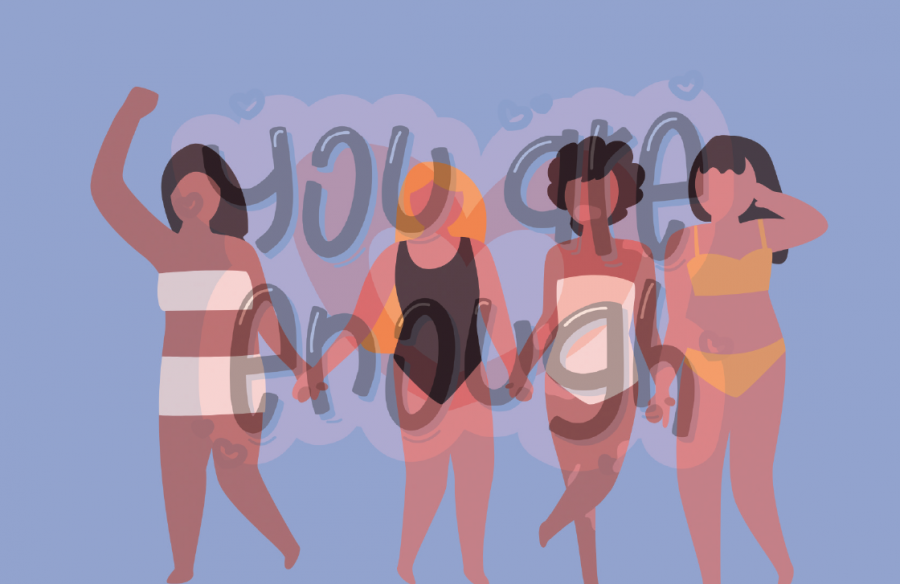Media impacts body images of VHHS students
Content Warning: This article focuses on eating disorders and mentions self harm.
Whether you have social media or not, I guarantee you’ve been a witness to toxic body shaming. You might scroll through your discovery page on Instagram and find yourself comparing sizes with models, hear a commercial about the “new diet pill,” or look at weight loss billboards as you drive on the highway.
In all of these scenarios, it is inevitable that the media presents smaller body types as desired.
According to the National Eating Disorder Association (NEDA), eating disorders are estimated to have increased by 41% during quarantine and are known to be the most fatal mental illness (even more than depression, as they usually go hand-in-hand).
So many people struggle with their relationship to food, and as a society, we have not been educated about different eating disorders and proper ways to become healthy and recover. Specifically in our school, eating disorders are simply labels, definitions needed to be memorized for tests, desensitized disorders used as insults.
To combat this, Shona Moeller (she/her), a health teacher at VHHS, has been implementing a body positivity and neutrality curriculum in her health and Mind and Body Fitness classes.
“We have a whole lesson on what it looks like to be body confident and on how your body looks doesn’t necessarily indicate your health,” said Moeller.
This is so important as students need to prioritize their health, especially because two-thirds of teens spend four or more hours being influenced on social media everyday, according to a report conducted by Common Sense Media.
In order to adapt to her students, the curriculum has changed from previous years: the disordered eating chapter is during the mental and emotional health unit, and the body confidence chapter is with the nutrition unit. With this shift, Moeller hopes to provide a safe space for students struggling with eating disorders and body image issues as a result of the media.
“It’s a systemic thing. I really feel like discussions need to start way before high school,” she said.
I agree. To minimize the amount of students with eating disorders, these topics need to be taught in a comforting way, without simply defining these disorders and moving on with life.
Alan Sogolov (12, he/him) explained that the media’s perception of the perfect body used to take a strong hold on him, but now, he focuses on the positive impact of working out.
“I feel like at first, [the media] had more of a negative impact where I was like, ‘Oh, I kind of want to be like these fitness influencers,’ but eventually, it turned into a point where I workout to become the best version of myself,” he said.
Sogolov feels that the school can be more inclusive to all body types and can do a better job of providing resources to live a healthier lifestyle, and I think the same thing. For instance, VHHS can promote the LIFE class as it teaches kids how to properly cook, workout, lift weights, and be active without negatively influencing students.
Educating kids on how to actively live healthier lives is more effective than assuming that everyone already knows how to do that, according to Sogolov.
Veronica Wendt (12, she/her) agrees with Sogolov. She started feeling the pressure of the media in just seventh grade. One of her first memories was scrolling on Instagram and seeing posts of unrealistic body types.
“A lot of what I see is photoshopped and not completely real. There are plenty of women out there that show realistic beauty standards, for example, on Tik Tok,” said Wendt.
Tik Tok can be uplifting, but it also causes a lot of insecurities in teens as most influencers only post their most desirable aspects. Going along with this, if I see a diet-encouraging video or another trigger, I select the “not interested” button and keep scrolling. This filters out similar videos and allows me to ignore the body negativity coded into the media.
Often overlooked, NEDA reported that this body negativity leaves at least ten million U.S. males with eating disorders at some point in their lives.
Eating disorders result in a lot of pressures that male-identifying people face in society: they are rarely offered support when struggling with their body image and disordered eating because these challenges are usually associated with females.
In order to break down negative stereotypes, I find it helpful to avoid commenting on anyone’s body shape, size, or appearance. Instead, I compliment someone’s personality. This draws away from the importance of looks and focuses more on who someone truly is.
As someone who has struggled with eating disorders and body dysmorphia for as long as I can remember, the constant reminders broadcasted by the media were never helpful. Additionally, as someone who has been in recovery for over a year, I can confidently say that the media had the strongest impact on my body image.
Now, I use the media to my advantage by discovering influencers that love their real bodies, and this helps me find ways to embrace every part of my body too.
We need to break down these societal expectations and strive to focus on all of the wonderful things our bodies do for us.
I love how far my body-positive mindset has come, and I hope to help others achieve the same mentality.

